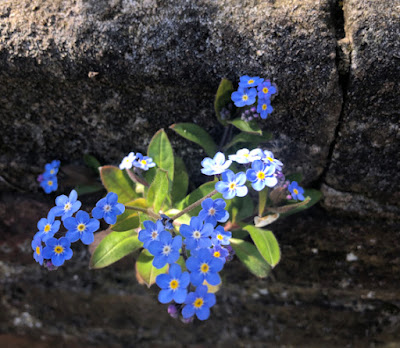With spring well underway, I’m spending quite a bit of my gardening time bending over to pull out weeds. Little and often is my method for keeping the worst weeds at bay, but what is a weed anyway?
In his book ‘Wild about Weeds’ (pub. Laurence King, Oct 2019), Jack Wallington describes weeds as rebel plants. He advocates in favour of weeds, writing “Not all weeds are uncontrollable brutes ... by learning how to grow weeds in unexpected ways, you will become a better gardener with a more interesting garden.”
Throughout the year the gardens here are interestingly studded with bittercress, chickweed, goosegrass, spear grass - rebels that I definitely don’t want to encourage, however dainty bittercress may look in its short moment of flowering. Bizarrely, I don’t mind Herb Robert growing in the shade under a hedge and have been known to leave patches of nettles tucked away as they provide food for butterflies. (The horsetail, on the other hand, is a story for another day.)
Jack’s weeds, however, are mostly of the more garden worthy type - rampant self-seeders such as toadflax, polemoniums, Ox-eye daisies, to name just a few. To this I would add nasturtiums, foxgloves, honesty, calendula, poppies, honeywort - and more. I have willingly introduced all of these rebels into the gardens.
Currently the most prolific ‘weed’ is the forget-me-not - Myosotis sylvatica or M. arvensis, one of our native plants. They seed around so generously that I was allowed to pick small posies of them in childhood. In recent years I really hankered after these again, having seen them flowering in a border that a neighbour looks after. She very kindly dug up a few plants for me. Now I have hundreds ... every year.
This is both a good and a bad thing. Good because Forget-me-not flowers provide an early food source for mason and solitary bees, and other insects, when there might be very little else growing; bad because they are very, very vigorous self seeders, unless you chop the flowers off. I prefer to let them seed around, knowing that I’ll have to dig up or transplant the seedlings when they appear.
That’s something I totally didn’t do last year which is why I have a raised bed stuffed with them. A clever gardener would have quickly planted black or burnt orange tulips among them last autumn. Isn’t hindsight wonderful?
Although Forget-me-nots will seed into every nook and cranny, as I know only too well, their preferred habitat is to grow in moist ground such as woodland edges, boggy ground or by streams - so they would make a pretty border for a garden pond.
They are supposed to flower from early spring right through to summer. In the somewhat arid conditions of the veg patch garden, seed pods are already visible.
I rather like to see them growing out of walls, alongside paths, under the fruit trees and in between the paving stones - all that cheerful colour for minimal effort (on my part at least). Those will be left well alone but any that have colonised my veg beds will have their marching orders this weekend as I need the soil back.
What will I do with the picked flowers? Dorling Kindersley’s Pocket Encyclopedia on flower arranging, bought for pennies from a charity shop some time ago, tells me that Forget-me-not flowers ‘last quite well in water’. Freshly picked flowers should be allowed to stand in deep water for several hours and kept cool.
I favour the pick and plonk method, straight into a tiny vase where I can see them. I might also dry a few by pressing between sheets of paper (blotting paper is best) and leaving under heavy books for a week or two.
Which weeds, if any, are you battling with? Or any favourites?
Let me know!
Caro x




Horsetail is the bane of my life! I always try to leave a patch of nettles and dandelion for the butterflies too. You had me laughing out loud re your raised bed stuffed full of forget-me-nots!Yes, hindsight is a wonderful thing for sure.xxx
ReplyDeleteOh my gosh, me too, Dina! Horsetail, horseradish - both a ruddy nuisance! Luckily I've found that if I pull it out as soon as it appears, eventually it will weaken if not altogether give up.
DeleteThat raised bed of forget me nots is over now, having succumbed to hot dry weather so that's one problem sorted before next year! xx
Beautiful! I like blue flower!
ReplyDeleteThanks, Endah! I like the blue too, so much nicer than the pink colour they start out with. Also bees love blue flowers so having lots of these forget-me-nots in the garden is a very good thing.
DeleteReally enjoyed this post. I'd love a garden of ox-eye daisies and nasturtiums. I've tried to grow ox-eye daises a couple of times but they wouldn't. I've always wanted to grow forget-me-nots too but was disconcerted when I took over my allotment because they would pop up in places where they were in the way. I felt ridiculous digging up the very plants I'd always wanted!
ReplyDeleteAhh, Lucy! So lovely to hear from you and have news of how you're doing from your blog. So pleased to learn that life is slowly improving for you. If you ever want any ox-eye daisy plants, let me know - I've been composting literally hundreds of them but there will be more .... ! I sympathise with having to get rid of wanted plants just because they're in the way - it's the story of my gardening days!
Delete